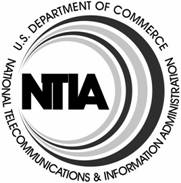Publications
Use the filters below to narrow publications by offices, programs or categories
Changes, Challenges, and Charting New Courses: Minority Commercial Broadcast Ownership in the United States
With this report, Changes, Challenges, and Charting New Courses: Minority Commercial Broadcast Ownership in the United States, the National Telecommunications and Information Administration (NTIA) revisits the important topic of minority ownership of broadcast facilities. The agency, through its Minority Telecommunications Development Program (MTDP), has collected data on minority ownership since 1990, and issued reports annually from 1990 through 1994 and from 1996 through 1998. In 1995, NTIA published a report on the availability of capital for minorities trying to enter the broadcasting business. This report provides an historical perspective on minority ownership and an assessment of the impact that the recent trend of broadcast industry consolidation has had on minority ownership.
ESIGN Report: The Consumer Consent Provision in Section 101(c)(1)(C)(ii)
On June 30, 2000, Congress enacted the Electronic Signatures in Global and National Commerce Act ("ESIGN" or "the Act"), to facilitate the use of electronic records and signatures in interstate and foreign commerce by ensuring the validity and legal effect of contracts entered into electronically. Careful to preserve the underlying consumer protection laws governing consumers' rights to receive certain information in writing, Congress imposed special requirements on businesses that want to use electronic records or signatures in consumer transactions.
Although participants expressed a range of views, it is reasonable to conclude that, thus far, the benefits of the consumer consent provision of ESIGN outweigh the burdens of its implementation on electronic commerce. The provision facilitates e-commerce and the use of electronic records and signatures while enhancing consumer confidence. It preserves the right of consumers to receive written information required by state and federal law. The provision also discourages deception and fraud by those who might fail to provide consumers with information the law requires that they receive.
The consumer consent provision in ESIGN appears to be working satisfactorily at this stage of the Act's implementation. Almost all participants in the study recommended that, for the foreseeable future, implementation issues should be worked out in the marketplace and through state and federal regulations. Therefore, Commerce and the FTC recommend that Congress take no action at this time to amend the statute.
|
ESIGN Report: Effectiveness of Electronic Mail in the Delivery of Records
Section 105(a) of the Electronic Signatures in Global and National Commerce Act ("ESIGN Act") directs the Department of Commerce ("Department") to conduct an inquiry and report to Congress on the effectiveness of electronic mail in the delivery of records, as compared with the delivery of records via the United States Postal Service and private express mail services.
|
Report to Congress Electronic Signatures in Global and National Commerce Act Section 105(a) June 2001 |
Federal Long-Range Spectrum Plan
Prepared by Working Group 7 of the NTIA Spectrum Planning Subcommittee
Current and Future Spectrum Use by the Energy, Water, and Railroad Industries
Public Law 106-553, The Departments of Commerce, Justice, and State, the Judiciary, and Related Agencies Appropriations Act, requires the National Telecommunications and Information Administration (NTIA) to consult with other federal agencies and departments responsible for regulating the core operations of entities engaged in the provision of energy, water, and railroad services and to report to Congress no later than one year after the Act’s enactment on the current and future use of spectrum by these entities to protect and maintain the Nation’s critical infrastructure.
NTIA reviewed the information collected through comments, reports, and other sources of information. NTIA presents its findings in this report based upon such data. NTIA found that providers of energy, water and railroad services submitting comments for this report had concerns regarding their current and future spectrum requirements. In addition, federal agencies who regulate the core operations of these industries (or some aspect of those operations) generally concur with comments by the industry and its representative trade organizations.
An Assessment of the Viability of Accommodating Advanced Mobile Wireless (3G) Systems in the 1710-1770 MHz and 2110-2170 MHz Bands
This NTIA document summarizes the findings of NTIA, the FCC’s 3G Working Group, the DOD, and other members of the Intra-Government 3G Planning Group (IG3GPG). The IG3GPG assessed the 1710-1770 MHz and the 2110-2170 MHz bands to determine if those bands present viable options for accommodating advanced mobile wireless systems. The 1710-1770 MHz band is used by a number of Federal agencies for fixed microwave systems, airborne and land mobile systems, satellite command and control operations, radio astronomy, weapon control systems, and video surveillance systems. The 2110-2170 MHz band includes common carrier, multi-point distribution, paging, radiotelephone, local TV transmission, and private point-to-point service licensees. The 2110-2170 MHz band is also allocated to the mobile satellite service downlink. During earlier efforts, these particular bands had been identified as offering the greatest potential for additional spectrum for advanced mobile wireless services.
NTIA CY 2002 Annual Report
NTIA Report on calendar year 2002 programs, initiatives and accomplishments, as required by the Public Telecommunications Financing Act, Pub. L.No.95-567, §402, 92 Stat. 2405, 2424 (1978).
|
|
NATIONAL TELECOMMUNICATIONS AND |
Spectrum Resource Assessment in the 5650-5925 MHz Band
This report is a Spectrum resource Assessment of the 5650-5925 MHz band. Included in information on rules and regulations, allocations, technical standards, frequency assignments, system characteristics, and applicable compatibility analysis.
Background Study on Efficient Use of the 2700-2900 MHz Band
This report summarizes the findings of an analysis that addresses accommodating new radar systems in the 2700-2900 MHz band based on projected growth in the band and projected radar deployment patterns.
FM Spectral Modeling and FDM/FM Simulation Programs
This report is concerned with the spectral representation of analog frequency modulated (FM) signals, with particular attention to frequency division multiplexing (FDM)/FM satellite communication systems. The FM spectral modeling and gaussian approximation principles are analyzed and extended to develop computer simulation programs capable of providing representative FM spectra.


